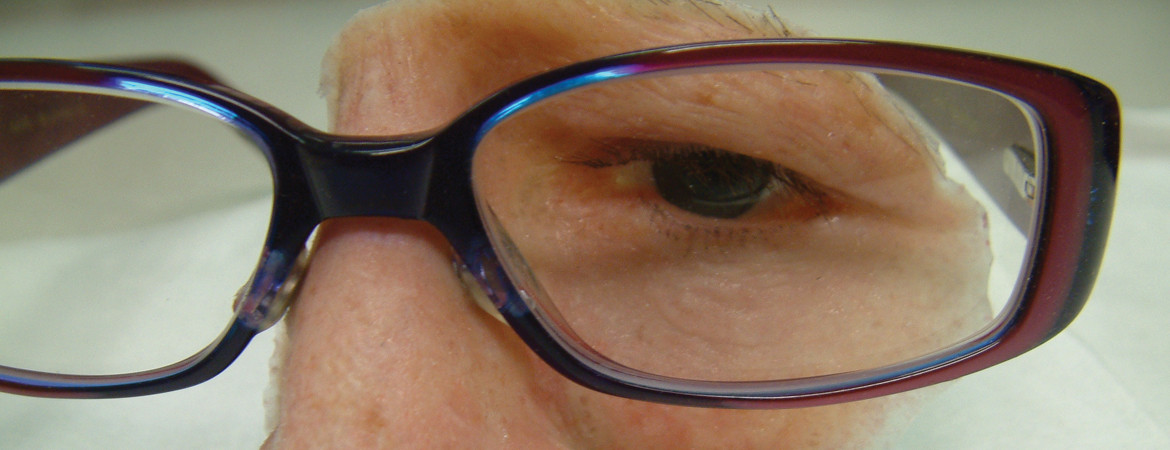
The field of Maxillofacial Prosthetics in the UK provides a wide variety of prostheses and medical devices. A list of some of the work undertaken includes:
Prostheses
- Facial and Body prostheses
- Eye prostheses and cosmetic shells
- Breast and nipple prostheses
- Custom made body implants
- Polands syndrome, Pectus Excavatum
- Titanium skull implants
- Eyelid weights
Other Non Prosthetic clinical procedures
- Micro-pigmentation (medical tattooing)
- Skin camouflage
Custom made splinting devices
- Burns splints
- Keloid scar splints
Surgical planning
- Jaw surgery (Osteotomy) and Facial or Craniofacial surgical planning
- Cleft lip and palate
- Medical Modelling
- Surgical Simulation modelling
- Surgical appliances to help after trauma
Custom made medical device manufacture
- TMJ appliances
- Tracheal oesophageal valve modifications
- Sleep apnoea devices
- Oral obturators (specialist dentures)
- Nasal septum obturators
Intra-oral prosthetics
Maxillofacial Prosthetists are registered with the GDC and are able to provide a wide variety of custom made dental devices.
WHAT IS A PROSTHESIS? WHO MAY BENEFIT FROM ONE?
Facial prostheses usually encompass the ears, nose, cheeks and lips and the area including the eye and eyelids. If the eye and the eyelids have been removed this is usually called an ‘orbital prosthesis’. If the eyeball has been removed and the eyelids are still in place the prosthesis to replace the eyeball is called an ‘indwelling’ eye or ocular prosthesis.
Body prostheses, sometimes called Somato prostheses, usually include everything else apart from the face. This could be the nipple, breast, the hands or fingers and also missing skin on the legs or arm.
WHAT ARE THEY MADE FROM?
This really depends on where the site of the defect is. If it is a skin defect then it will usually be made of a soft material called medical silicone. This is a very skin like material that is soft to touch and can be coloured to match the surrounding skin.
Eye prostheses are made from a material called acrylic (plastic). They are hard and can be highly polished to copy the other eye.
If the prosthesis is an implant to replace bone or muscle and skin it can be made from a silicone (soft for muscle or skin) or a metal such as Titanium (to replace bone).
WHAT IS MICROPIGMENTATION? WHO MAY BENEFIT FROM IT?
It is a method of applying pigment into the skin. It can be described as a medical tattoo that is used to blend colour into the skin. It is not permanent like a normal tattoo and the colours are based on skin tones of the body so should blend into your skin.
It may benefit patients who have had a nipple reconstruction, patients who suffer from alopecia, trichotillomania, scars, vitiligo and cleft palate lip repairs. It has also been used in self-harm scarring.
Your Maxillofacial Prosthetist should have undergone specialist training to carry out this procedure. Ask for certification.
WHAT IS SKIN CAMOUFLAGE? WHO MAY BENEFIT FROM IT?
Skin camouflage is a selection of creams and powders used to mask unwanted colouration of the skin. Copying the colour of the surrounding area. Patients with scars, birthmarks and non-infectious skin conditions such as rosacea, vitiligo and psoriasis may benefit from this type of treatment.
Skin camouflage products differ from normal cosmetics in that when correctly applied the camouflaged area is water-resistant, therefore long lasting and usually contains sun protection (SPF15). Most skin camouflage products used are available through the NHS and can, at your doctor’s discretion, be prescribed.
To provide this treatment, we have to have been trained either by the British Association of Skin Camouflage (BASC) or by the Red Cross.
British Association of Skin Camouflage (BASC): www.skin-camouflage.net Red Cross: www.redcross.org.uk/
CUSTOM MADE SPLINTING DEVICES
What is a keloid splint? Who may benefit from it? A keloid is a type of scar. It is a result of an overgrowth of granulation tissue at the site of a healed skin injury. Keloids are firm, rubbery lesions or shiny, fibrous nodules. Keloids should not be confused with hypertrophic scars, which are raised scars that do not grow beyond the boundaries of the original wound.
A keloid splint is a device made usually in acrylic (plastic) or some other type of thermoplastic material which applies controlled pressure on the keloid to stop it growing and help to reduce it or flatten it.
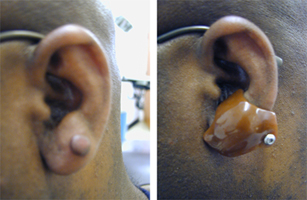
A KELOID SPLINT WHAT IS A BURNS SPLINT? WHO MAY BENEFIT FROM IT?
A custom made burn splint is designed to provide direct pressure over the burned area to help prevent unwanted build up of scar tissue. It also controls the affected area from unwanted skin contraction when the wound is healing. It may also provide a physical barrier to protect the burn from any contact with the environment to avoid infection.
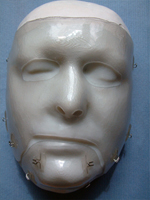
A burns splint
SURGICAL PLANNING
In cases where patients are having surgery to their jaws or bones of the face, the Maxillofacial Prosthetist carries out planning before the operation. This involves producing an exact duplicate model of the patient jaws or bones and carry out the surgery to the models to check it will work. This plan will then be used to finalise the surgery with the Surgeon.
These models will also be used to make custom made surgical guides so that the surgery is carried out exactly as planned.
This is usually carried out where patients are having procedures such as:
- Jaw surgery (Osteotomy) and facial or craniofacial surgical planning
- Oral or facial cancer removal
- Cleft lip and palate repair
- Implants placed in the jaws for teeth or for facial prostheses
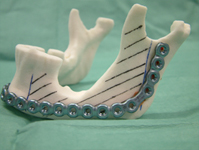 Plan to remove a lower jaw cancer |
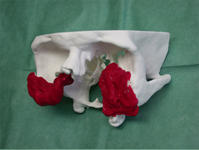 Plan to remove facial cancers |
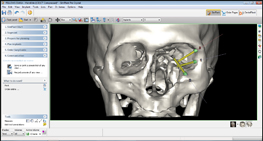 Implant placement plan for a prosthesis |
CUSTOM MADE MEDICAL DEVICES
Maxillofacial Prosthetists provide many different types of custom made devices.
These will sometimes be for common conditions such a those to control jaw pain (TMJ devices), devices to prevent sleep apnoea and reduce snoring (Mandibular Advancement Devices) and devices to help after surgery of the mouth to protect the surgical site (a cover-plate).
Specialist dentures called Obturators are made to fill holes in peoples mouths made after the removal of cancers, surgical defects after removal of teeth or from defects in the jaws from birth such as a cleft palate. This cavity can interfere with speaking, swallowing and chewing if left open. They are usually held in place by the remaining teeth, dental implants or as an extension to an existing denture.
INTRA-ORAL PROSTHETICS
Maxillofacial Prosthetists are registered with the GDC and are able to provide a wide variety of custom made dental devices including dental prosthetics, orthodontics, crown and bridge prosthetics and other specialist devices.



